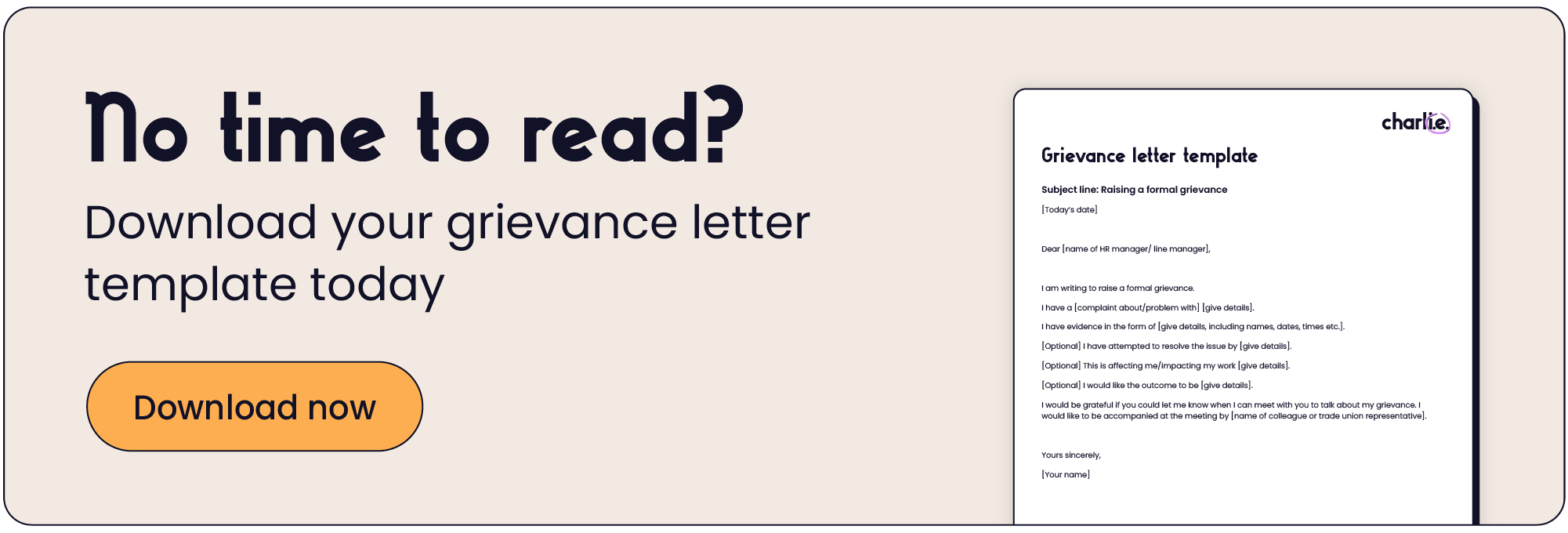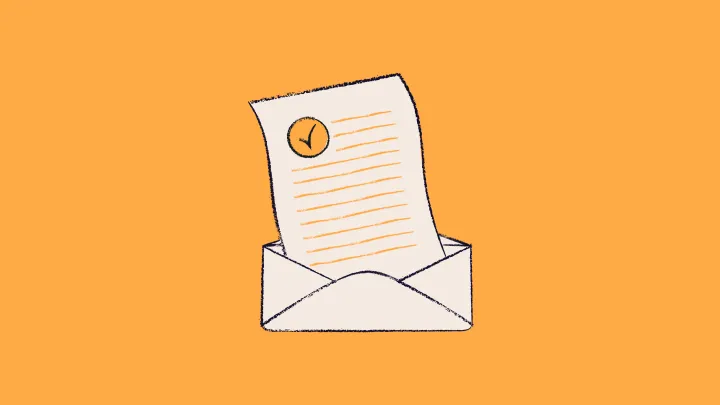How to write a grievance letter (with free grievance letter template)

Do you need to know how to write a grievance letter? Or want to better understand when a letter of grievance should be sent?
Then this is the blog for you.
As a Charlie CIPD-qualified advisor, I help small businesses and startups improve the way they support their employees, and that includes during formal grievance procedures.
I know what a grievance letter should contain and in what circumstances you should write one. And this blog is designed to take the guesswork away, and help you to feel more confident that you’re doing everything right.
And because raising a grievance means you’re likely to be in a stressful situation, I’ve also included a free grievance letter template for you to download and use. All you need to do is fill in the blanks and send your letter of grievance to the appropriate manager.
What is a grievance letter?
If you’ve never gone through a grievance procedure at work before, then it’s unlikely you’ll know what a grievance letter is for.
No matter the business, and if you want to raise a formal grievance at work you have to put it in writing – that’s done through a grievance letter (also known as a letter of grievance).
In a grievance letter, you:
- formally set your complaint down in writing (raising a grievance)
- detail how it is impacting you or your ability to do your job
- request a meeting with your manager to discuss your grievance further.
All businesses, whether big or small, should have a clear and accessible grievance policy in place. The policy explains the grievance procedure step-by-step, and tells employees who they need to send their grievance letter to. Typically, a letter of grievance will be submitted to a line or HR manager.
A grievance letter sets the grievance procedure in motion, which your employer must follow promptly, properly and fairly.
Why raise a grievance?
The decision to raise a grievance is not an easy one, but typically occurs when attempts to solve a problem informally have failed. Raising a grievance is the formal way of calling attention to a problem, where an employee asks their employer to step in and help.
There may also be cases where an informal solution doesn’t feel possible or right, so raising a formal grievance becomes the only option.
Commonly, someone raises a formal grievance when:
- They’ve not worked out a solution with informal attempts
- They don’t want it dealt with informally — for example, unrealistic workload or job expectations
- They have raised a very serious issue that requires investigation and intervention — for example, sexual harassment, bullying, discrimination, or critical health and safety.
Can you be disciplined for raising a grievance?
If you’ve never raised a grievance before, you may be worried that you could be punished, disciplined or even fired for doing so. Just know that all employees are protected by employment law from being treated unfavourably because of raising a grievance.
In the context of raising a grievance, being unfairly disciplined or dismissed is known as victimisation.
The main purpose of the grievance procedure is to provide employees with a mechanism to resolve problems in the workplace. So if you are experiencing problems at work then you should not be afraid to raise one.
Raising a grievance is also helpful to the employer, as they can step in before something grows into a much bigger, and potentially costly, problem.
An employee who raises a grievance is protected by the grievance procedure, which the employer must follow. All businesses should have their own grievance policies and procedures in place, otherwise they must follow the Acas Code of Practice on disciplinary and grievance procedures.
Raising a grievance: what an employer must consider
When someone raises a formal grievance through a grievance letter, an employer has a lot they must consider:
- The grievance procedure - knowing what steps to take when a grievance is filed and ensuring fair and consistent handling.
- Effective communication - having empathy, understanding, and a commitment to resolution is crucial.
- Conflict resolution - finding a fair and equitable resolution that addresses the root cause of the grievance.
- Adhering to legal requirements - understanding the legal obligations surrounding grievance procedures and ensuring all actions and responses to grievances comply with employment laws and regulations.
- Proper documentation - accurately documenting the entire grievance process, from the initial complaint through to the resolution. (Incomplete or inaccurate documentation is problematic, especially if legal issues arise later.)
- Timely resolution - acting promptly is important as delays can escalate a situation and negatively impact all parties.
- Preventing retaliation - consistently nurturing a culture where employees feel safe to voice concerns without fear of reprisal.
- Learning and improvement - continuously evolving HR policies and procedures to prevent similar problems arising in the future.
- Building and maintaining trust - successfully addressing grievances is essential for trust between employees and management.
For these reasons, many small businesses seek external support to help them navigate the tricky grievance landscape.
Support in the form of HR experts like Charlie. Hundreds of small business owners and their teams access bespoke advice and on-demand expertise through our HR Advice Service.
How to write a grievance letter (i.e. What to include in a letter of grievance)
It’s important to understand how to write a grievance letter because it kickstarts the entire grievance procedure.
A letter of grievance should list the problem or complaint (the grievance), and provide enough detail so an employer can begin to investigate it. It is also useful to include information about any informal resolution attempts.
A grievance letter should be:
- Brief and to the point
- Factual (keep to the facts and steer clear of emotive language)
- Neither abusive or offensive
- Explanatory (your employer needs to understand what’s been going on).
A grievance letter can also include details of how the employee has been personally affected and of any outcomes they would like to see.
To make writing a letter of grievance easier and less stressful, I’ve included a free grievance letter template with this blog.
Grievance letter template
Whether you’re a manager, an employee, or an HR professional, this grievance letter template is free to download and use, and in line with the Acas code (a code of practice that sets the minimum for an employer to follow when handling grievances at work).
Using this template to write your grievance letter into an email or letter document.
Subject line: Raising a formal grievance
[Today's date]
Dear [name of HR manager/ line manager],
I am writing to raise a formal grievance.
I have a [complaint about/problem with] [give details].
I have evidence in the form of [give details, including names, dates, times etc.].
[Optional] I have attempted to resolve the issue by [give details].
[Optional] This is affecting me/impacting my work [give details].
[Optional] I would like the outcome to be [give details].
I would be grateful if you could let me know when I can meet with you to talk about my grievance. I would like to be accompanied at the meeting by [name of colleague or trade union representative].
Yours sincerely,
[Your name]
So that’s a letter of grievance!
Hopefully you now feel more informed and confident about writing a grievance letter, and understand why and when you might need to ever send one.
And if in doubt, remember: the grievance procedure exists to help you out, not catch you out.




